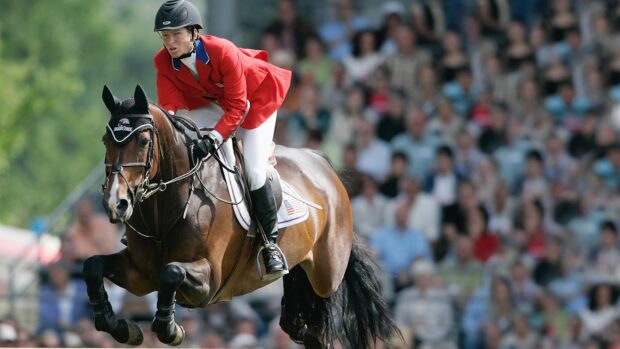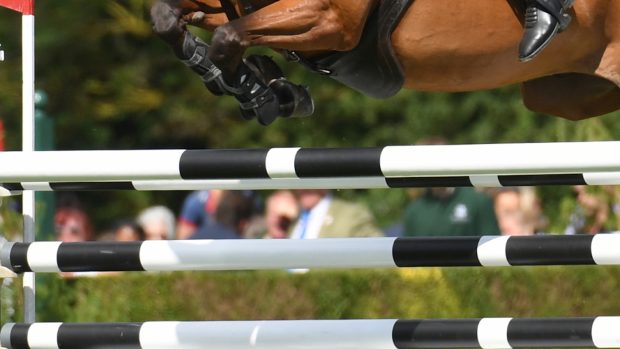By an Arab stallion, Pretty Polly swept the board in the 1950s, winning championship after championship and creating a legacy both in the show ring and via her progeny. Nicola Jane Swinney talks to those who remember her as we celebrate Horse & Hound’s 140th anniversary in 2024
FOR those brave souls who take on the professionals in open pony classes, Pretty Polly is their chance to stand in the spotlight – the classes introduced by the British Show Pony Society (BSPS) for home-producers only.
What some “newbies” may not realise is that Pretty Polly was a real pony; one who swept all before her in the 1950s, ridden by the young Davina Whiteman, long before she and her mother Joan Lee-Smith founded Ponies Association (UK).
 Watch the video
Watch the videoPretty Polly was foaled in 1945, by the Arab stallion Naseel out of a Welsh/thoroughbred mare called Gypsy Gold, bred by Stephanie Nicholson of Co Meath. As Tom Best says in his definitive book The History of the British Riding Pony: “This cross highlighted the role of Arab blood in the breeding of the developing British riding pony, at a time when there was some prejudice against its use.”
It is worth noting that, not long after the end of World War II, horse and pony breeding was booming, and in many ways indiscriminately so, compared with today when breeders are highly aware of supply and demand.
Jennie Loriston-Clarke, of Catherston Stud, recalls: “They [breeders] were experimenting with all sorts in those days. People were getting youngsters off the Welsh hills and crossing them. We had a thoroughbred stallion and we bred him to pony mares.”
Jennie has cause to remember Pretty Polly because she was one of the few to vanquish the pony in the ring, at the 1953 Royal International with Royal Show.
“She was a very pretty pony,” Jennie (then Bullen) recalls. “Being part Arab, she had a lovely head and she went very well for Davina. And she had tremendous presence; she had that rare ‘look at me’ quality.”

Pretty Polly with Davina
On that occasion, however, Jennie headed the class with Royal Show.
“The judge that day was Major Faudel-Phillips,” says Jennie, “and he was a stickler for limb. Royal Show was a sturdier sort, more like today’s show hunter ponies, and that’s probably why we won.”
So it is not correct to say that Pretty Polly was unbeaten. But her victories vastly outnumbered her losses.
As a four-year-old, she was champion pony at the 1949 Dublin Spring Show on her debut. The judge that day, Horace Smith, commented: “She was an outstanding pony who was ridden by a too-large jockey who covered her up.”
He wasn’t her only admirer at Dublin Spring; she was spotted by Robert Hanson, who knew Keith Lee-Smith was trying to find a 14.2hh (148cm) show pony for Albert Deptford, one of his owners who was known at the time for breeding Suffolk horses and cattle. But Pretty Polly’s then owner, Mrs Gray, wanted £1,000 for her – an enormous sum of money in those days.
A deal was struck: the pony would be brought to England with a load of six hunters and, as Albert was going to be at the Great Yorkshire Show, he could see Pretty Polly there, ridden by Davina Lee-Smith. If he liked her, he would have first refusal.
In the space reserved at Great Yorkshire for the mounted police exercise, Davina tried the pony for the first time.
Once she was comfortable in walk, she asked Polly to trot on – and the sale almost fell through there and then when Keith observed that Polly was not level.
Davina pulled her up, and the pony was found to have one thick “carthorse shoe” on one foot and a light show plate on the other. No wonder she wasn’t level. Yet even with this, observers noted her beautiful floating trot.
The deal was done, and the story that Albert Deptford had bought a four-year-old Irish champion pony for four figures – more than £30,000 in today’s worth – gained traction. Such a price had never been known before, so Polly had a lot to live up to.

Royal Show ridden by Jennie Bullen (now Loriston-Clarke), was one of the few ponies to beat Pretty Polly.
Her first show was the now defunct British Timken. Polly didn’t let anyone down; she looked superb and she went like a dream to win her class and the championship. She swept all before her, winning championship after championship, and at Horse of the Year Show (HOYS) at Harringay in 1950 she scored 98 marks out of 100 for conformation and 100 out of 100 for way of going.
Renowned equestrian author Pamela MacGregor-Morris, who wrote show reports for Horse & Hound, described her as a “perfectly made pony”.
Polly repeated the feat in 1951, and it is quite possible that she’d have done the same in 1952 but for a now-defunct rule that meant the previous year’s champion was barred from competing. She was champion pony at the Royal Show and the Royal International for three years running.

Pretty Polly and Davina Lee Smith being presented with the Queen Mary Challenge Cup at Richmond Royal Horse Show in 1953 by the Duchess of Norfolk. Pic by Sport and General
Pretty Polly became so famous that her name lives on, some 70 years later. H&H columnist Stuart Hollings recalls seeing her in the much-missed parade of champions at HOYS.
“I was fascinated to see this legendary pony in the flesh,” he says. “She must have been in her twenties then and was a broodmare, but was being ridden for the occasion. As soon as the spotlight went on, she pricked up her ears and you could see her eyes light up.”
Jennie Loriston-Clarke confirms that the mare had that rare quality: “Some ponies come into the ring with their ears flat back, then just grow. Polly was like that.”
Legendary she might have been, but Polly was not a one-off. The Naseel-Gypsy Gold cross produced a brother, Eureka, and sister, My Pretty Maid, a 13.2hh, among others. At the Royal International in 1950 when Polly took the championship – as if by right – My Pretty Maid stood reserve and Eureka second reserve. The following year, Polly was champion again, with Eureka reserve and My Pretty Maid second reserve. My Pretty Maid went on to be pony of the year in both 1953 and 1955.
After her stellar career, Polly became a successful broodmare. Her progeny have followed in her elite hoofprints and made their own marks in the pony breeding world.
THERE is a rather lovely addendum to Pretty Polly’s story. Seeing the pony in the ring at the Royal International at White City in London in the 1950s, a pony enthusiast was entranced by her, saying: “She was one of the most famous riding ponies at the time. As soon as I saw her I thought, ‘What a lovely pony. I’d like to breed ponies like that.’”
That pony enthusiast was Marlene Davey of the Ninfield Stud, which for more than 50 years produced its own legends. Marlene used Wingrove Minkino – a son of Bwlch Valentino – as her stallion and his offspring included Ninfield Great Expectations, Ninfield Minks Splendour, Ninfield Millionaire and Ninfield Minks Enchantment.
Ninfield ponies are still competing today, some of them – fittingly – in those Pretty Polly home-produced classes whose championship is at the Royal International.
The Arabian influence
AFTER World War II, Glenda Spooner – best known for her welfare campaigns – encouraged the use of Arab stallions to produce children’s riding ponies.
She promoted “first cross” classes at the now defunct Ponies of Britain shows. Her influence worked; several of the leading riding pony studs started using Arabian bloodlines.
In the 1960s and ’70s, Arab or part-bred Arabs, such as Bwlch Valentino – whose sire’s dam Silverspray was an Anglo Arab – had a significant effect on the breeding of the British riding pony.
They produced a finer, prettier animal, with extravagant movement, and many pony studs used them on their mares. Among them was Cusop, whose lines from Valentino via his grandson Cusop Disciplin still appear in modern pedigrees today.
Interestingly, the National Pony Society has registered show ponies as a distinct breed called the British Riding Pony.
High society
THE National Pony Society (NPS) was formed in 1893, largely concerned with registering polo ponies, most of which were of Arab or eastern breeding and brought back by army officers to play the game here. Then small thoroughbreds were used to add speed and, later, the height limit for polo ponies was relaxed. The smaller ones were adopted for children to ride.
In 1949, the NPS was asked to set up rules for ridden pony classes but refused to do so, believing its remit was registration only. A number of pony enthusiasts therefore set up their own organisation, and the British Show Pony Society was born. John Tilling was chairman, Brigadier John Allen vice-chairman, and a committee was formed to canvass for members, among them Sybil Smith, Ronnie Driver and Keith Lee-Smith.
Many years later, Keith’s wife Joan and daughter Davina formed Ponies Association (UK). Davina, then Whiteman, passed away in December 2019 at the age of 78, having left a wonderful legacy for the showing world.
You might also enjoy reading…

Stay local and no ride judges as showing prepares to restart *H&H Plus*

Horse of the Year Show announces 2021 showing qualifiers
'We recognise the huge responsibility we have to the industry, and that we have to make certain that the qualifiers

Stuart Hollings: ‘Let’s re-introduce some fun classes’ *H&H Plus*

HOYS champion Rafeekah: the complete showman with a lovable character *H&H Plus*
At only six years old, the striking grey Arab gelding landed his first Horse of the Year Show title. Alex

Subscribe to Horse & Hound magazine today – and enjoy unlimited website access all year round
Horse & Hound magazine, out every Thursday, is packed with all the latest news and reports, as well as interviews, specials, nostalgia, vet and training advice. Find how you can enjoy the magazine delivered to your door every week, plus options to upgrade your subscription to access our online service that brings you breaking news and reports as well as other benefits.




